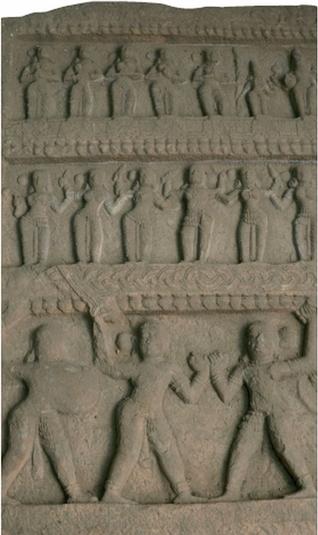
The space is not commensurate with the number of artefacts on display-exhibits made of stone are often kept on the ground in poorly lit corners and at locations that hamper visitor movement.
A visit to the district museum is unlikely to figure in the list of places one likes to spend time on a holiday. For, not many know that there exists a museum in almost every district in the region, which partly has to do with it low-key presence in locations where the rent is affordable. Invariably the locations are government owned buildings.
The poor patronage has to do with the way the museums are maintained. The space is not commensurate with the number of artefacts on display-exhibits made of stone are often kept on the ground in poorly lit corners and at locations that hamper visitor movement. In some museums a few items are in the open, outside the premises.
Security at the museums is another issue. In a few museums, valuable finds are no longer there as the Department of Museums has shifted it to Chennai. Historians and history enthusiasts, who wish to remain anonymous, want the Tamil Nadu Government to improve the museums in the region in such a fashion that they become a sought-after destination.
The Hindu looks at some of the museums in the region and how they fare.
In Udhagamandalam, the Government Museum is awaiting new place – the wait is around a quarter-a-century old. And, it will end in 2015 when it moves to the Connemora Cottage. At present it functions at a rented building on the Ooty-Mysore Road.
The Connemora Cottage is near the historical Stone House, which now forms part of the Government Arts College. The Cottage, constructed in 1884-85, is named after Lord Connemora. At its present location, the Museum attracts only about a hundred visitors a month during the off season period. During the season, the Curator K.A.Murugavel claims, the flow increases. The items on display are coins, megalithic burial urns, tribal goods, stuffed birds, rock art, palm leaf manuscripts and a few musical instruments. A few stone idols have been displayed at the entrance.
Geetha Srinivasan, Convenor, Indian National Trust for Art, Culture and Heritage (INTACH), the Nilgiris Chapter, says the potential for developing the museum is enormous.
In Erode, the Government Museum enjoys the advantage of a good location – it is opposite the VOC Park. This makes the visitors to the Park to hop into the Museum. On an average, not less than 1,000 persons, most of them students, visit the Museum.
Inadequacy of space is, however, conspicuous. Though moving to its own permanent building on a sprawling area would be the permanent solution, the Department of Museums is understandably in a dilemma since there is no certainty that the existing public patronage will continue. The array of stone sculptures placed outside the museum is enough indication of the space constraint.
“Space is a constraint. But the inculcation of the sense of history that the Museum is now able to ensure by virtue of its location is of higher importance,” said S. Jayasankar, Professor of History and Principal of Vasavi College.
Among the prized possessions at the Government Museum is the statue of Lord Dakshinamoorthy dating back to 12th century, the oldest among the collection of statues. Urns used for storing grains, burial urns and materials used by Sholaga tribe of Erode district reflect the civilization in the region.
An excavation at Kodumanal in the district being carried out by a team of Pondicherry University is expected to add to the collection.
In Tirupur, a newly carved district, the demand for museum has only increased. Dr. K. Manivannan, a historian, told The Hindu that a museum was essential for Tirupur so that lots of hero stones and other valuables artefacts presently lying scattered or under the possession of different persons could be brought under one roof.
Hero stones, commemorating the death of persons who have laid down their life in battle or died while fighting for the cause of a particular community, can be seen in places near Thirumoorthi Hills and Gudimangalam, he said.
R. Sangameswaran, an Assistant Professor of History, said setting up a museum would enhance the tourism in the district.
In Salem, the District Museum, functioning since 1975, has exhibits related to numismatics, philately, stone balls and canons, exquisitely-carved stone sculptures and display on articles used by the British. Among the interesting exhibits are the six burial urns that were unearthed in Musiri, Omalur, Mohanur, Kamalapuram and Salem. Each weighs about 80 kg.
A 300-year-old stone carving that was retrieved from Pethanaickenpalayam in Attur that depicts a man taming a bull is on display. A picture of this was submitted as a proof to the Supreme Court in the Jallikattu case to show that the bull taming existed in olden days as well.
Also the wardrobe and articles used by Namakkal V. Ramalingam Pillai were also on display. But those that are in display are in competition with those that are lying dumped in a room, in dust.
Members of the Salem Historical Society had been asking for revamping the museum for a better display of the exhibits, said its secretary J. Barnabas.
Curator M.N. Pushpa told The Hindu that proposal for constructing a new building has already been submitted .
In Coimbatore, the Government Museum is in a pitiable condition because exhibits of historical importance are few. Apart from a few stone idols, urns, megalithic tools and wood carvings from a temple car, there is very little. The floor is damaged and roof is full of cobwebs.
With inputs from D. Radhakrishnan, R. Krishnamoorthy, R. Vimal Kumar, S.P. Saravanan and Karthik Madhavan
source: http://www.thehindu.com / The Hindu / Home> News> Cities> Coimbatore / by Coimbatore Bureau / Coimbatore – August 02nd, 2014